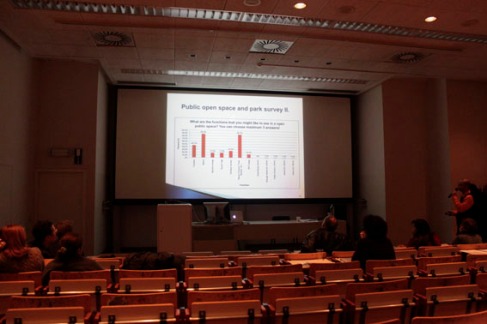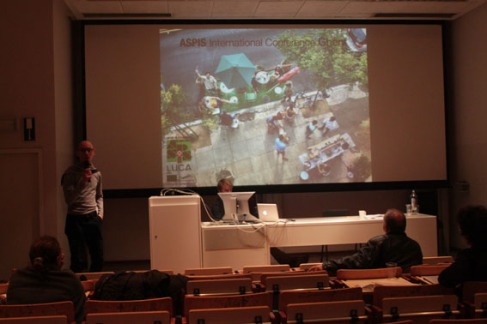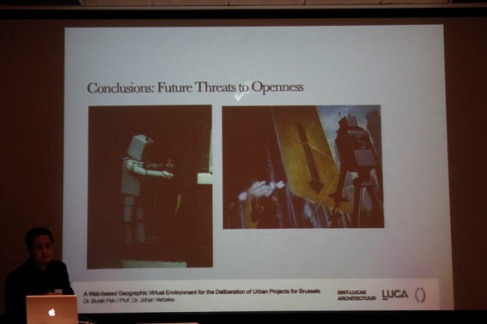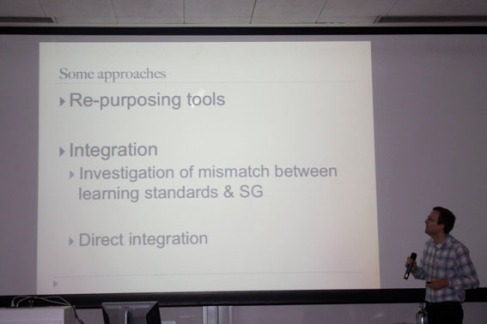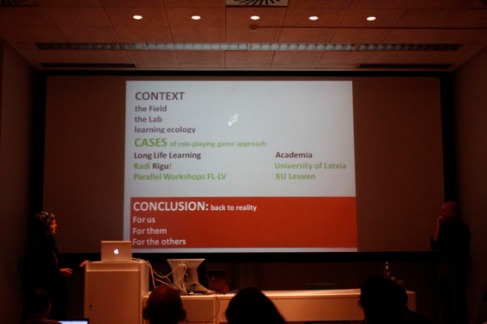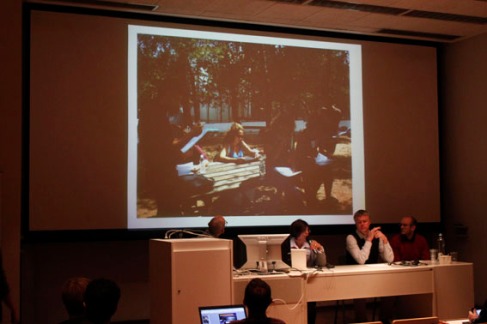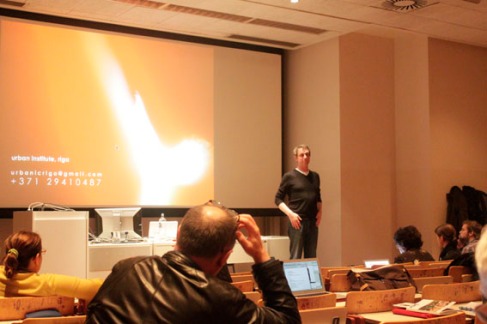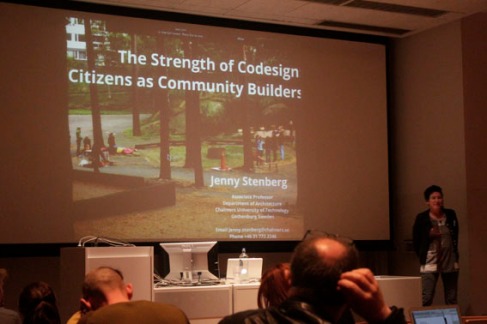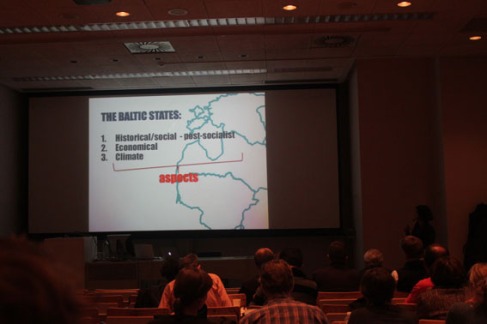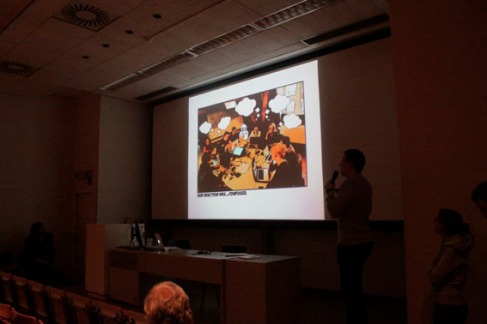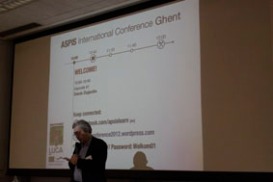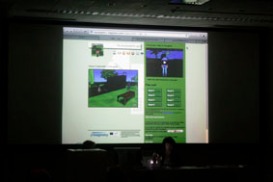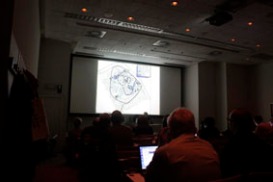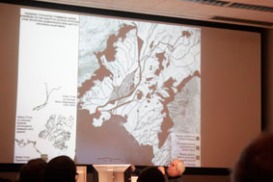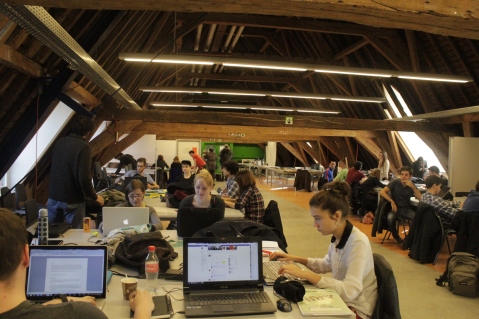ASPIS Conference Gent(BE)_Live Reporting: Day 02(PM)
End of the ASPIS Conference here in Gent (BE) 2012.
We want to thank again all people involved in the conference. A special thanks goes out to the students and professors of Luca for the smooth running of the conference. We wish all the people a save trip home. But first a coffee and some discussion.
Here are this afternoon’s summaries:
Livia de Bethune: Participation in public space projects in Brussels, some casestudie
Livia de Bethune makes us aware how important and interesting it can be to design a public space in collaboration with the local inhabitants. The idea is to discuss with the inhabitants from the beginning of the design all the way through until the proposal is finished. They work on their proposal and in different stages they show their progression in different media (models, plans,…). The collaboration can go from games for youth to neighbourhood walks with the inhabitants. Also they try to present projects from students to give creative ideas for different areas in Brussels.
Meriç Demir: The spatial organisation of public spaces in terms of communication and urban public life
Meriç Demir explains the definition and etymology of the term communication, communication is the way in which people come to possess things in common and has two roles: a spatial role and an instrumental role. Unfortunately the private is becoming oversized and this undermines the urban public life. She ends her talk with the following statement for thought: “the spaces that do not belong to anyone change into the spaces that belong to everyone.”
Stefanie Cornut: Building with society – Architecture as an instrument to affect social change
Stefanie presents her masters’ thesis dealing with social sustainability in Brussels. Everyone has the right to shelter, the aim is to design a home for people but also a place in society. ‘Familiar strangers’ are people you do not necessarily know but you do recognise. Place attachment is an important concept: not trying to achieve social cohesion but finding ways that people can live together through sharing the same space. The idea is to create a variety of dwellings with more shared and communal spaces, encouraging people to spend time in public space, “architecture is not only about shaping space, but also about creating place.”
Laszlo Jona: Aspects of utilization and sustainability in a public space – a Hungarian example
Batthyay square: a park and a square, in the city centre of Gyor with public institutions around it, shopping centres and university. In the past (around 1849) Batthyay was a military point. Today the place has a lot of problems: not well maintained, the public lavatory is closed, a lot of rubbish, football field in bad conditions, forbidden to smoke but everybody does. After some analysis last year, Lazslo found out that the park has a good pedestrian traffic and that they need a bicycle path and a dog running field. Finally, the big problems in the square come from poor maintenance but this can be solved by the people deciding how they will use the square in the future.
International Master of Architecture Students II: ROJM EXtended, a design studio report
INTERNATIONAL STUDENTS_GROUP#3
Each member is in a different group in the design studio and they decided to look at what they all had in common in current design task at the Tinelsite. Five central themes came up: flexibility, comfort zones, borders and boundaries, visuality and social interaction. Through these themes, which are all related, the students try to give a few main principles through sketches and diagrams from the design studio. In this way the students try to give their insight on how public space relates to its environment socially and in a sustainable way.
INTERNATIONAL STUDENTS_GROUP#4
This group of students presents their book of proceedings and the way they achieved it in the days leading up to the conference.
Here are some photos:
ASPIS Conference Gent(BE)_Live Reporting: Day 02(AM)
The morning sessions of day two are over and we had some interesting talks on participation and as David Wortley calls them: serious games. Here are the summaries:
Luc Wallys (Omgeving) – Keynote Speaker
Luc Wallys has started off the day talking about the different aspects of participatory design, which he sees as very relevant tools in the design process:
1. Participation as a source of inspiration
2. Participation as a source of information
3. Participation as a design tool
4. Participation as a design guideline of the existing context
5. Participation as a tool of social control
Conclusion: participation is hardly a recipe for success, the main thing is how the information is interpreted. Public control does not always determine the future of the project. “Participation is good thing, but it’s not a magic formula.”
Burak Pak: The potentials of affordable Geoweb 2.0 applications to support the deliberation of urban projects, working with Professor Johan Verbeke
There is a need for integrated affordable planning environments due to problematic urban situations, such as in Brussels.
– The problem of brusselization – different historic neighbourhoods have been deconstructed in the name of ‘urban planning’.
– Within the potentials of the geoweb 2.0 we find the transformation of participation and geospatial technologies.
– It is a web based geographic virtual environment for the deliberation of urban projects for Brussels.
Maurice Hendrix: Re-using Serious Games by encapsulating them in Learning Objects
The presentation concerns the sustainability of computer games with the purpose of education. Learning tools nowadays have a very wide spectrum so it is important to try and connect to an audience in an entertaining way. This is not easy because once a game is created, it is very hard to change the game itself, only small changes are possible. The most important way is to investigate how courses can be exchanged and how the intended pedagogy should be defined. It is not easy to assess the standard of existing games. The most important part is to know if the game works for its specific context, establishing if users have learnt from it.
Helçna Gûtmane & Marc Geldof: Games-based learning in planning: training programs for professionals and students
The presentation is about trying to bring the field and the lab together in the design process. Participation plays a main role and it is sought to encourage everybody to take part – from designers, architects and planners to other participants such as the locals and government. Urbanists and designers should be ready to listen and communicate with all possible participants in order to take people out of their usual role as passive end-users. For Helçna Gûtmane and Marc Geldof, designing and creativity is a means to an end: “Use design as a tool to create social life”.
Simona Sofronie: A locative urban game to collectively visualize spatial tactics. Discussion of a case-study, working with Professor Oswald Devisch.
The game is a tool to support participative processes; providing information for architects, raising awareness and increasing motivation. Games and architecture have the power to reinforce each other through the right balance of playfulness and seriousness.
– Pervasive games: transforming the familiar environment into a play space.
– Location based games: use the city as a playground.
In testing a site specific game was created: in Hasselt, analysis of the site to create a frame, from this game scenarios were produced. The game is connected with Facebook and SMS, creating habits using existing platforms. The interactive game was carried out over five days. Unexpected factors were found to have meaning and relevance, data which architects were then able to use.
David Wortley: The ASPIS learning tools
A presentation about how games could become a tool to teach, especially trough simulation and role playing games. With the APSIS game the aim is to promote learning for public participation in urban planning. It is a single player role-playing game based on a character ‘Peter’, who makes certain quests. A example for a quests could be colleting suggestions and gathering evidence. It addresses difficulties that will be encountered during a urban planning assignment.
ASPIS Conference Gent(BE)_Start of day two!
Day two is imminently about to start with the keynote speaker Luc Wallys.
We will keep you updated throughout the day.
ASPIS Conference Gent(BE)_Live Reporting: Day 01(PM)
End of day one, here is a short summary of this afternoon presentations.
Part 1: Designing Public Open Spaces with Public Participation
Jonas Buechel: The ‘Community Development Training Program’ in Latvia
Jonas has started the afternoon session by questioning the value of public participation – are people asking for participation or is the state imposing this idea? In order for there to be participation, activation, stimulation and provocation are needed. Change management is needed for effective participation, through education tools and community workers to form a collaborative idea about space. Educated community workers to facilitate participation in a constructive way. “…community work promotes the process of life.” The training programme will educate these community workers to generate collaboration, cooperation, support civic awareness and participation. Possible outcomes include the formation of strong and self-reliant communities.
Jenny Stenberg: The Strength of Co-design: Citizens as Community Builders
Through a specific project in the suburbs of Goethenburg, Jenny has described the participation process in for urban design. The aim of the project is to form the links between education, outreach and research. A number of techniques were successfully used: an ‘idea party’, workshops, discussions, exhibitions and a ‘test party’ for the initial designs. The idea of social tenure is key – everyone has the right to propose ideas and information during the process. If everyone is involved citizens can become community builders.
Caroline Claus and Bram: Download Lomap and let the world know what you think of your neighbourhood or city!
Caroline Claus and Bram are working on two open source, itc based tools to map one’s neighbourhood, focusing on the youth. The project is about taking a subjective lomographic photo to show the rest of the world how you feel about an area. The photos are uploaded online so it is possible for everyone see all the different mappings. The emotional and human experience gives a different angle, providing valuable information for urbanists, architects, etc… to get to know an area on a human level. Map your own neighbourhood: www.lomap.be
Nele Vanhooren: Citadelpark, a participation track seen from the perspective of the Municipality
The project is the regeneration of the Citadelpark in Gent. The park has lots of potential but also lots of problems created by its form and location. Many different buildings and functions, location between the main train station and the city centre all means a huge number of different stakeholders. Objectives for the regeneration of the park were established through meetings with the stakeholders. Participation and communication were an integral part of the project organisation. Long-term and short-term goals were agreed, these short-term goals have been implemented to show the community that progress is being made, building trust.
Part 2: Sustainability and climate in public open spaces
Margarita Karavasili: Towards Sustainable Cities: Improving urban environment through open spaces’ bioclimatic interventions
Traditionally, decisions and designs were based on economics, form and functions. Because of this, our environment has suffered greatly. It is necessary to change the way we have been living and working in recent years – public participation is necessary for sustainability. Public space today is at an interesting junction, fighting privatization and commercialization. However using these public spaces can help sustainability, upgrading open spaces to provide micro-climates and reduce the heat island effect. Physical properties affect the social characteristic of public open spaces and can also be used in this way to contribute to sustainability.
Jekaterina Balicka: Use of public space in Baltic countries and climate aspects
A presentation about the multifunctional seasonal use of different public spaces in the Baltic countries. During the summer every open space can become a public space, in winter, public spaces are often used for storage, of snow, unused benches etc. Some examples of temporary activities throughout the year in one space, demonstrates the importance and significance these events can have. A design for public space that functions throughout the whole year should be simple, inviting and universal.
International Master of Architecture Students I: ROJM EXtended, a design studio report
Teams of international students working on a design project focusing on the design of public space, within the context of a youth centre and masterplan in the city of Mechelen. The many stakeholders on the site with different requirements will be the challenge for our design, how to achieve social sustainability. Working in collaboration with the local residents, ROJM youth centre users and the city council we will try to achieve a new inclusive programme that can provide new possibilities for all of these stakeholders. Based in the city of Mechelen in West-Flanders, the site comprises the new holocaust Museum, an old monastery that will be converted to a library, housing, and the youth centre which caters for 90% youth of Moroccan and other minority backgrounds. The programme of the project is the task of designing this youth centre and the public spaces that connects all of the different functions on the site. It is not just the issue of ‘green’ to create a sustainable public space but also accommodating the different expectations, whether cultural, religious or social, of the individuals.
Discussion of Reflections on Day 1:
– Open spaces create possibilities, allow for activities to happen.
– Connectivity – we must stop thinking about public and private, all open spaces can interact.
– There are perhaps two ways of thinking emerging, the ‘other’ space where people are doing something different from at home (social ideology of heterotopias), connecting of public and private may only work on an ecological sustainability level.
– Porosity – public and private space in common use, continuity – common in southern Mediterranean European states, this is maybe different in Baltic States.
– Public vs. private: global discussion on urban design, LOVE should be important, everyone wants to be loved, have a sense of belonging. People give and take from the public realm in transition between the two.
Some photos:
ASPIS Conference Gent(BE)_Live Reporting: Day 01(AM)
The conference kicked off with a fundamental view on the ‘Myth’ and sustainability or even the ‘Myth’ of sutainability. The first series of presentations combined theoretical backbones of public open space with case studies from Estonia, over Spain, Athens in Greece and Istanbul in Turkey.
Here is a short summary of the speakers from this morning.
Keynote speaker, Denis Dujardin:
Denis Dujardin has started the conference by posing interesting topics for reflection concerning the sustainability of the urban landscape. High maintenance landscape designs that we see in many cities, do not seem a sustainable solution as when the intensive upkeep ceases, they will return to their wild nature. He proposes, is this the imposition of human interference or the interference of nature reclaiming human imposition?
Fouli Papageorgiou, coordinator ASPIS:
Summary of the aims of the ASPIS group and an overview of the product of their work and research, this conference the culmination of the work from the last few years. The IT tools that have been developed, sustainability game, star rating tool and memory game, will be discussed further in the conference. All are available at: www.aspis-learn.eu
Friedrich Kuhlmann: Baltic perceptions on the sustainability of public open spaces
Looking at the start of the project, Friedrich explains how the sustainability criteria evolved. The meaning the terms ‘public space’ and ‘sustainability’ have very different connotations in different countries, depending on culture and background. It was established that the most important factors are the multiplicity of activities, ‘life going on’ in a way tied to events and seasons, as well as the idea that continual investment should not be needed to maintain a public space.
Hèctor del Alcàzar Indarte: Valencia, the city with no-river. The relationship between public space and city.
Hector has given synopsis of the development of the city of Valencia that highlights the importance of the participation of citizens with the city authority in order to create an urban landscape for the benefit of society. Following the diversion of the river the citizens successfully campaigned to turn the old riverbed into a linear public park, which is now the green backbone of the city, rather than a highway as were the original plans of the city.
Konstantinos Moraitis: Antonis Tritsis Park as a Center of a Future Environmental and Landscape Network, in the Metropolitan Territory of Athens
There is a plan to form a ‘necklace’ of the open void in the city of Athens, a green network of the parks and open spaces. This is proposed with a number of layers, activating the urban streams, using the open railway lines and the major avenues of the city, to connect the city to the coastal zone and the mountainous areas surrounding the city. The idea is to invert the perception of environmental design, rather than putting nature into the city, connections are created that allow the invasion of nature from the outside.
Handan Turkoglu, Meriç Demir: Evaluation of the urban open spaces in Istanbul
Handan emphasises the importance of the social aspect of sustainability of public urban spaces. She mentions different aspects of successful urban spaces: socially liveable, accessible, economically viable and ecologically sustainable. The importance of the social value is highlighted by incidental spaces that have evolved rather than planned.

